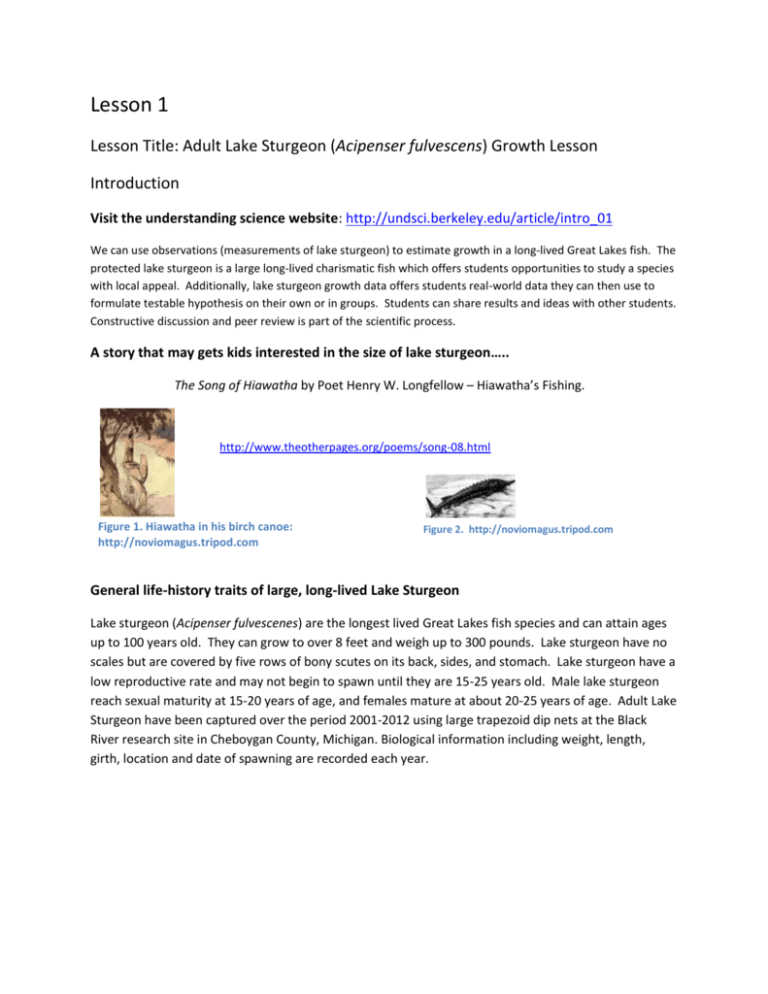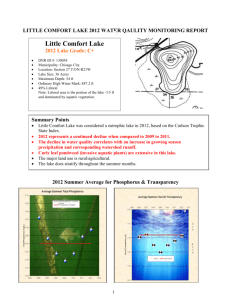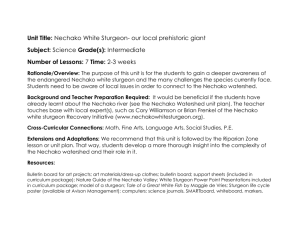docx
advertisement

Lesson 1 Lesson Title: Adult Lake Sturgeon (Acipenser fulvescens) Growth Lesson Introduction Visit the understanding science website: http://undsci.berkeley.edu/article/intro_01 We can use observations (measurements of lake sturgeon) to estimate growth in a long-lived Great Lakes fish. The protected lake sturgeon is a large long-lived charismatic fish which offers students opportunities to study a species with local appeal. Additionally, lake sturgeon growth data offers students real-world data they can then use to formulate testable hypothesis on their own or in groups. Students can share results and ideas with other students. Constructive discussion and peer review is part of the scientific process. A story that may gets kids interested in the size of lake sturgeon….. The Song of Hiawatha by Poet Henry W. Longfellow – Hiawatha’s Fishing. http://www.theotherpages.org/poems/song-08.html Figure 1. Hiawatha in his birch canoe: http://noviomagus.tripod.com Figure 2. http://noviomagus.tripod.com General life-history traits of large, long-lived Lake Sturgeon Lake sturgeon (Acipenser fulvescenes) are the longest lived Great Lakes fish species and can attain ages up to 100 years old. They can grow to over 8 feet and weigh up to 300 pounds. Lake sturgeon have no scales but are covered by five rows of bony scutes on its back, sides, and stomach. Lake sturgeon have a low reproductive rate and may not begin to spawn until they are 15-25 years old. Male lake sturgeon reach sexual maturity at 15-20 years of age, and females mature at about 20-25 years of age. Adult Lake Sturgeon have been captured over the period 2001-2012 using large trapezoid dip nets at the Black River research site in Cheboygan County, Michigan. Biological information including weight, length, girth, location and date of spawning are recorded each year. Objectives: Students will be able to apply Lake Sturgeon capture data to become more familiar with spreadsheet and database analysis using common biological parameters. Students will be able to graph and compare growth, spawning periodicity, and spawning location between male and female Lake Sturgeon. Students will be able to write a hypothesis as a statement that answers a question or offers explanation for an observed phenomenon. Students will be able to identify and explain data that; supports their hypothesis, refutes their hypothesis, is inconclusive regarding their hypothesis. Subjects: Biology or Life Science Grade Level: 7-12 Duration: Materials / What You Will Need: * USFW Sturgeon (Bowen) Presentation and Michigan Natural Features Inventory of the Lake Sturgeon * Process of Science PP and/or additional background on the process of Science from the Understanding Science Website, www.understandingscience.org *Computer Lab with Excel 2007 or higher *Data sets Adult Lake Sturgeon Growth. Procedure: Day 1 1. Discuss the process of conducting the adult lake sturgeon population census survey. Begin discussion about how, where and when the survey is conducted. Also, describe the details or methods associated with the information collected. Topics to discuss during the lecture may include: a. Survey is conducted in the early spring when river temperatures reach 11 degrees Celsius. This is typically when Lake Sturgeon begin entering the river to spawn (Link FORSYTH PAPER). Discuss observations of repeatability of timing and location of spawning and the environmental cues adults use to guide decision of when to migrate. b. Survey is conducted on the Black River below Tower-Kleiber Dam. Sample sites are listed as “Zones” and are numbered 1 thru 7. Zone 1 (abundant large rock) is the farthest most upstream sample region which is characterized more as a prime spawning area compared to habitat located say in Zone 7 (abundant fine sediment/sand). c. Data collected are used to estimate harvest numbers as well as provide researchers with baseline information regarding lake sturgeon growth and reproduction. 2. Provide students with the data from Excel. 1. 2. 3. 4. 5. 6. 7. a. Now that the students have the data, they can transform the data from Metric to English units. Scientists collect data using Metric units to accommodate how most of the world collects their data. This makes comparing results across geographical regions much easier. i. This exercise is done simply to show students how to convert Metric to English, check the Tools manual for more information. b. Now that the raw data has been converted, ask the students to develop questions about features of the data which may be useful before any data are graphed. Based on the data collected what questions can the data are used to answer? List the questions on the whiteboard and select those questions which are mentioned most frequently by students. i. If not mentioned, other sample questions may include: 1. Are Male and Female Lake Sturgeon similar in size (total length, girth, etc.)? a. Answer: Typically female are larger in both total length and girth. 2. Do individual Lake Sturgeon prefer a specific spawning zone? a. Answer: Some evidence suggests that early spawners prefer more upstream habitats 3. Do Male or Female Lake Sturgeon spawn at similar intervals? In other words, can you tell from the data provided how often these adults spawn? a. Answer: It appears that males spawn every two years, while females spawn every three. 4. Why might researchers collect Fork Length if Total Length is already collected? What is the difference between Total and Fork Length? a. Answer: Total length is measured to the farthest tip of the caudal (or tail) fin. Often their fins are chipped or have been reduced as a result of aging so fork length often provides a more accurate estimate of growth over time. 5. In what year can researchers expect to capture Female #1 again? a. Answer: 2014 6. In what year can researchers expect to capture Male #3 again? a. Answer: 2012 Day 2 Instruct students on how to create a graph first by hand and then with Excel using the data provided during previous lecture. For Example, let us hypothesize that at first capture, the average Total Length is equal between that of male and that of female lake sturgeon. Instruct students to try and provide a biological explanation as to why there appears to be a difference between the sizes of first time spawning males versus first time spawning females. How does this affect their initial hypothesis? For example, if their null hypothesis was that male and female Lake Sturgeon would be similar in size at the first capture event, ask the students why this does not appear to be the case. With a partner, ask students to choose a question from the list of whiteboard questions created the previous day. Using the questions those students came up with; ask them to attempt to answer their questions using the graphed data that they create by hand or in Excel on their own. Utilize the Tools offered from the website to see examples of how data can be created or interpreted. Each group will need a process of science worksheet to guide the development of a hypothesis and prediction for their question. Allow time for students to analyze and compile data for their hypothesis. 8. Students present their initial question, hypothesis, data, additional questions that arose and conclusion for peer review and discussion. The teacher should keep a running list of the additional question that arose during the analysis. This is a good reminder of the circular nature of science.











